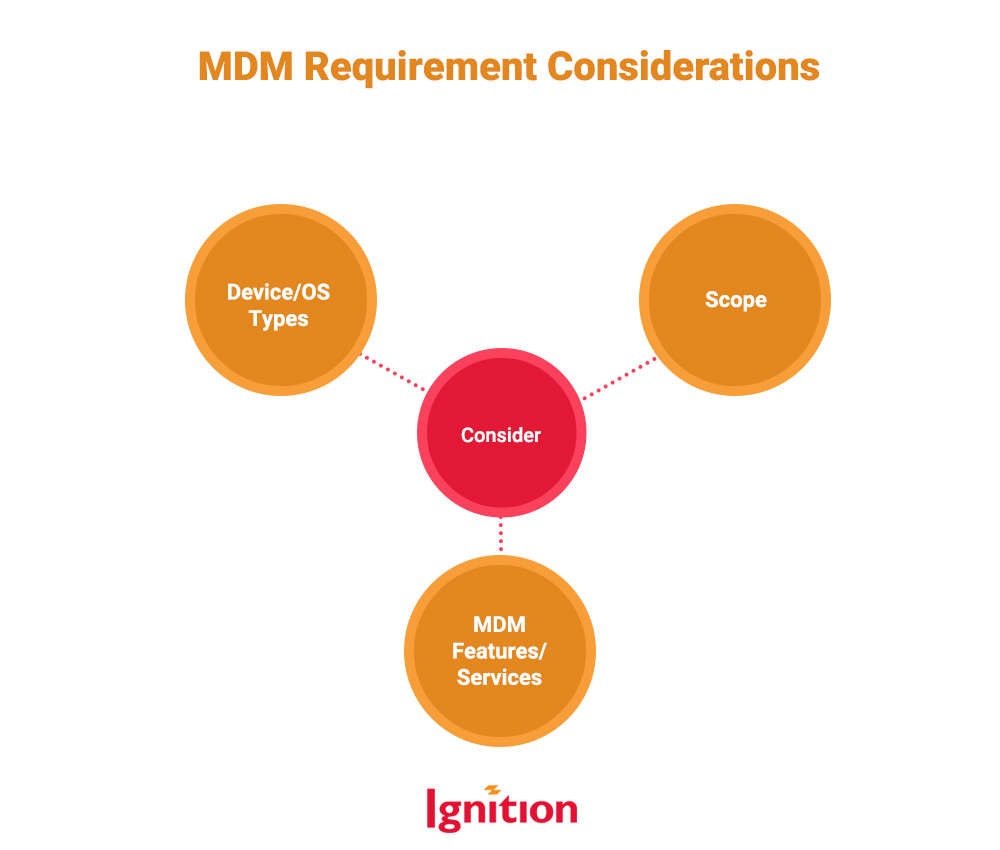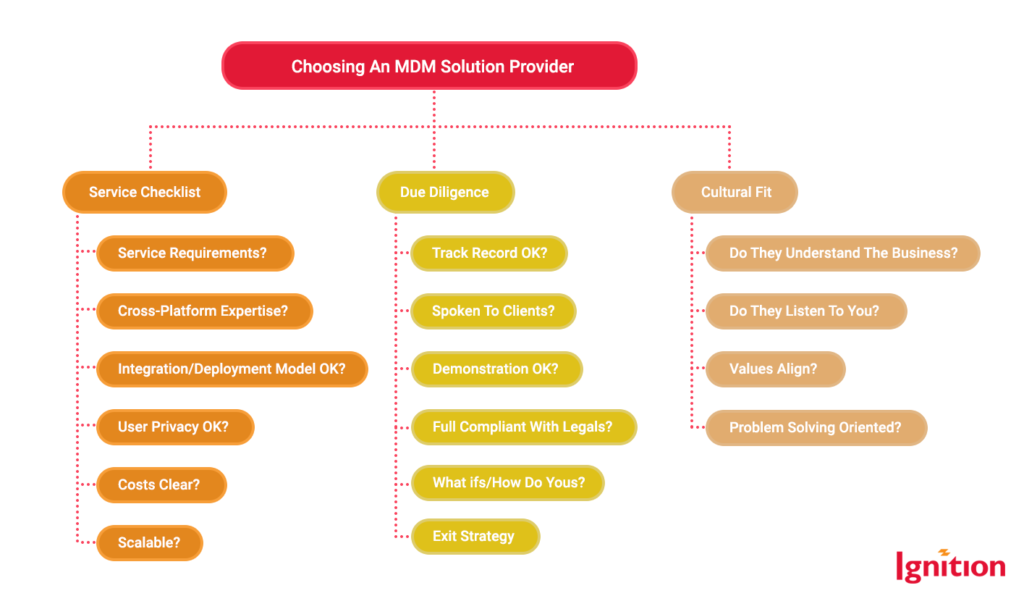All the big kids on the business playground have mobile device management (MDM), and you’re thinking it’s time you joined in. And for good reason – MDM is one heck of a shiny business asset that allows your people to work from anywhere flexibly, securely, and productively. Who doesn’t want that?
But when you’re faced with a desperate gang of MDM providers pleading, “Pick me! Pick me!” how do you choose the MDM solution provider that’s right for you? Here are four tips to help you find the right fit.
1. Read All About It
If you know that MDM is a good thing but are still a bit uncertain about the entire smörgåsbord of loveliness it can offer, it’s time to grab a coffee/muffin combo and do a little research. MDM isn’t just a technical thing: mobile device management is actually a blend of tech, policies, and people, so it makes sense to Google your butt off for an hour or so to gain a better understanding of what MDM can do and how it works in practice.
OR – you can save some time and check out the articles linked below in our Quick’n Dirty MDM Guide:
Quick’n’ Dirty MDM Guide
Click on the resource links below to learn all you need to know about MDM.
| Theme | Resource |
| MDM Basics | Basics of MDM |
| Onboarding | How MDM Supercharges Remote OnboardingDevice Onboarding for a Remote Workforce |
| Bring Your Own Device | MDM and BYOD |
| Data Security | Compliance: How MDM Helps With SOC 2How MDM Reduces Human ErrorDevice Configuration |
| Device Inventory Management | Device Management: Spare-tastic Adventures |
| Policy | Best Practice MDM Security PolicyMDM Policy: What To IncludeMDM Policy: How To Build One |
2. Define Your Business Needs
Once you’ve got a handle on the scope of MDM, it’s time to define your business needs. What do you actually want out of MDM? What business problems do you want to address? What do you want to be able to do that you can’t do now? This also raises the question of future-proofing: how will you need to operate in the future, and can MDM help with this?
Some common business reasons for adopting MDM include:
- Enhancing security and protecting data to reduce vulnerabilities after a scare.
- Changing working practices, e.g., from office-based to remote or a hybrid model.
- Recruiting rare skills from overseas or across the US safely.
- Scaling the business up quickly.
- Business strategies like acquiring SOC 2 or HIPAA accreditations or migrating to the cloud.
- Reducing downtime and productivity outages.
- Changing to a BYOD culture or offering a Choose Your Own Device (CYOD) perk.
- Saving costs by managing spare devices more effectively.
3. Define Your MDM Requirements
After you define what you’d actually like MDM to do for your business, it’s time to get into the detailed requirements. This clarifies to potential MDM solution providers what you’re looking for and gives you a baseline for comparison. Here’s what to think about:

Device Types. Have a good think about the types of devices your business uses and the operating systems and platforms they require. Maybe your designers love Macs, your salespeople work from Windows devices, you’ve got a fleet of iPads in kiosk mode, and everyone uses their Android/iOS/Whatever smartphones to collaborate remotely. MDM is perfectly suited to corral these diverse dogies with one lasso – but you will also need an MDM provider with the expertise and BYOD smarts to make it all work under a single pane of glass.
Scope. Will MDM cover freelancers and contractors, as well as your people? This one should be covered by your MDM policy.
MDM Features/Services. Here’s the fun part: specifying the MDM tasks that your shiny new MDM provider will take on. The sheer number of MDM capabilities can be overwhelming, so before you think about ordering everything on the menu, keep in mind your business needs. The no-brainer services to pile on your plate should include:
- Device monitoring
- Device security configuration & standardization
- IT asset inventory maintenance
- Patch and update management
- Security policy enforcement
- Data backup & recovery
- Remote lock/wipe
- Remote device troubleshooting
These are your standard security & monitoring services – add in the extras you’ll need that meet your business needs, such as:
- Automated onboarding for scalability
- Secure offboarding
- Device warehousing for spares management
- Application management
Up until now, this process might feel like a ton of hard work, but the effort you put in will make it so much easier to choose your MDM provider. You are fully informed about the capabilities of MDM, and you’ve clarified all the ways you’d like it to support your business.
Now – grab the popcorn because it’s Beauty Pageant Time! (Metaphorically speaking. We’re not suggesting you subject MDM vendors to the objectification of an Evening Gown Competition.)
4. Define Your MDM Provider Requirements
It’s important that your MDM service provider can actually do the job – but there’s more to it than that. If you’ve already got a robust IT procurement strategy, you can use those principles as a basis for selection, but if you don’t yet have one, check out these three basic areas:
Areas To Consider When Choosing An MDM Solution Provider

Service Checklist. This might seem straightforward, but it’s easy to overlook the not-so-obvious. If your vendor ticks all the boxes for providing the services and platform expertise you need, will their services also integrate seamlessly with your current IT infrastructure, or will there be blockages or friction? How will implementation and communications be handled? Can it scale easily when you need it to? Are you happy with their attitude toward user privacy? After all, your data will be in their hands. And is the pricing structure easy to understand, with no hidden costs? Does the Service Level Agreement seem realistic and reasonable? Make sure you’re happy with the answers to all of these questions.
Due Diligence. If the track record looks good and the demonstration went well, next, you’ll want to speak to some clients. Any MDM provider worth their monthly invoice will be happy for you to do so. If you have super-special compliance requirements – perhaps you’re HIPAA compliant, and your provider will have access to protected health information – make sure they can show that they’re up to the mark. Test out the What Ifs and How Do Yous, like:
- What if there’s a breach? How do they report one? What action will they take?
- What if the MDM provider’s systems are compromised?
- What if the MDM provider goes bust?
Don’t forget to agree on an exit strategy if things don’t work out.
Cultural Fit. It’s important that your MDM provider understands your business – how it operates, its pain points, and its priorities. Asking you lots of questions is a good sign. Organizational cultural fit is important, too: this is about attitude, communication, and problem-solving.
Choosing An MDM Solution Provider Doesn’t Have To Hurt
Unless you choose the wrong one, of course. Then it hurts reeeel bad. But it doesn’t have to be this way. Here’s an idea: give us a call, and let’s chat about the glory that is MDM. Ask us questions. We’ll ask you questions. Hey, you can even ask our clients some questions. We’re all for it! And if you’ve already got an MDM provider, but one too many things have gone wrong for too long, talk to us.
Ignition is Silicon Valley’s best (and friendliest) IT security, compliance, and support team. Contact us now – chatting about IT support and cybersecurity is our favorite thing to do!
